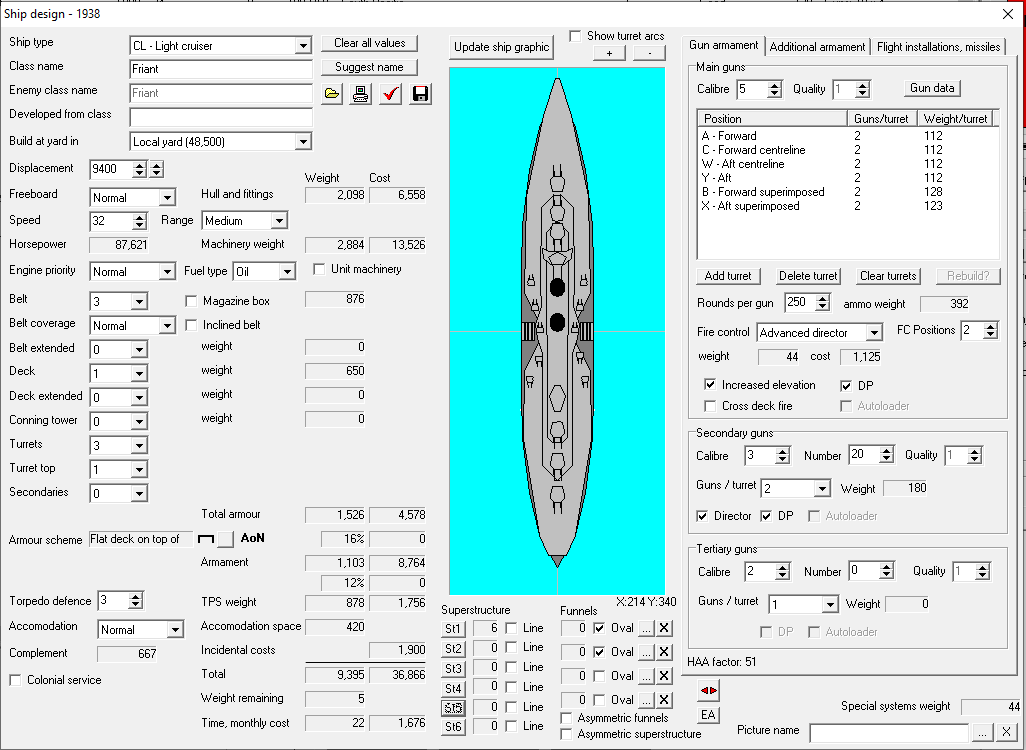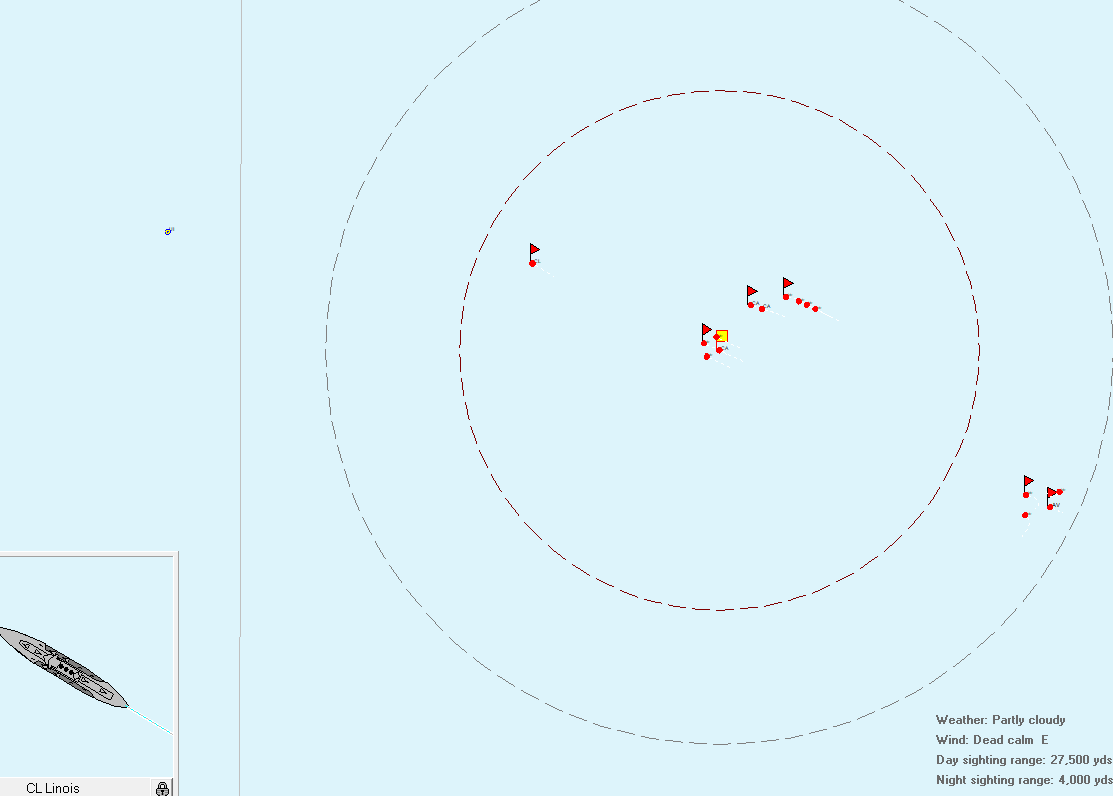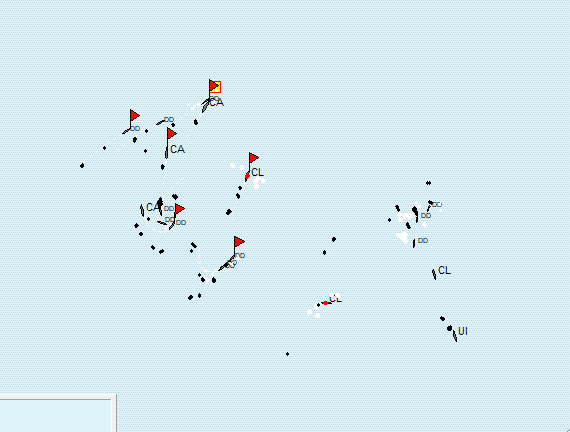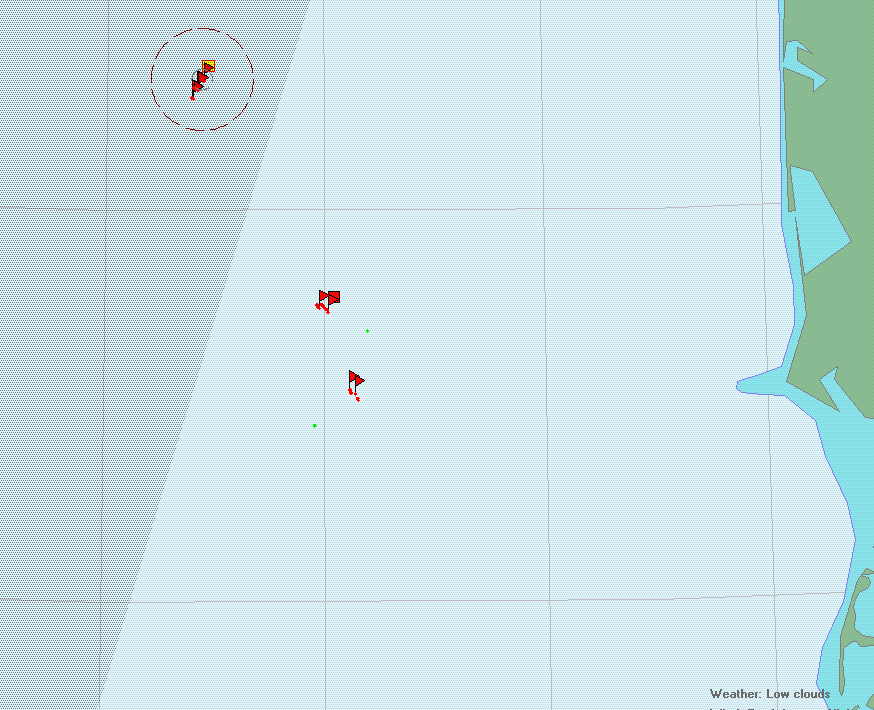The field agrees on more carriers, but is split on what to do with the rest of the budget. So, here’s my plan:
- When the battleship Solferino completes, start a new carrier.
- When the carrier Fraternité completes, start 2-3 light cruiser escorts.
- When next the budget allows, build another battleship.
March 1938
There is no battle this month—France declines to fight Germany near Jutland, France declines to fight Austria-Hungary in the Adriatic, Austria-Hungary declines to fight France everywhere else.
An enemy submarine torpedoes and sinks our light cruiser Friant, one of the three remaining Chateaurenaults puttering around on foreign service.
Otherwise, an uneventful turn.
April 1938
The Germans decline battle twice, when it would take them within striking distance of French land-based air.
They accept a convoy attack (that is, we’re fighting a convoy defense) far enough from the French coast that the dive bombers are out of reach. On the French side we have two light cruisers and a destroyer screen, so I don’t expect much of a glorious victory unless the Germans are not out in force.
I commit to the fight, gambling on the chance to sink an old German battlecruiser, but German torpedo gunnery seems to be more accurate than my own. We lose a light cruiser (Forbin, one of our newest ships) and four destroyers for my trouble.
May 1938
I decline a bunch of unfavorable battles. Our old battleship Lyon hits a mine and sinks; maybe it’s time to build a little minesweeper or two. There are also reports of food shortages in France thanks to merchant shipping losses. I crank up the number of destroyers under construction, and consider maybe combining a corvette-minesweeper into a slow destroyer.
In more positive news, I have a new AA picket light cruiser design:

June 1938
A surprise battle occurs in the eastern Mediterranean: a German squadron of unknown composition encounters a combined French-American cruiser squadron.
Steaming south of Heraklion, the French squadron heads east. It includes three heavy cruisers: our modern Latoche-Treville, and the obsolete American Frederick and Pueblo. Together, we have 17 9″ guns and 8 10″ guns, along with ten destroyers and air support from French bases in Kalamata and Benghazi.
Additionally, we have our old seaplane tender, Commandant Teste, in attedance. She launches some search planes.
Altough the weather is cloudy, one of Teste‘s floatplanes nevertheless spots a German cruiser, steaming east at the far end of Crete. My mismatched squadron, with a top speed of 27 knots, nevertheless sets off in that direction.

The two American ships date to 1923 (Frederick) and 1916 (Pueblo). Pueblo, at 15,000 tons, has armor nearly as thick as Latouche-Treville, and the only 10″ guns in the squadron. She’s the slowest of the three ships at 27 knots.
Frederick has the same 31-knot speed as Latouche-Treville, but is very lightly armored, and ships one fewer 9″ gun. Being American ships, however, they’ve been upgraded to the gills. Both sport advanced gun directors and search radar.
By late morning, Kalamata has launched an air strike. Dive bombers approach the enemy cruiser, still 60 miles from our force, at about 11:00 a.m. They hit it two or three times. A group of medium bombers, following up, score no hits. (Oh, how I long for the days when we can put torpedoes on medium bombers…)
At 12:14 p.m., our light cruiser Linois spots the enemy ship. We turn to engage.

The target, a Roon-class heavy cruiser, has taken some damage from bomb hits already, and is slower than our ships are now. Latouche-Treville scores the first main battery hits at 12:40, with three in one salvo from her six forward guns.
She has very much found the range, with at least one hit per minute for the next twelve minutes.
By 1:06, the enemy cruiser is on fire and slowing to five knots. I believe it ships torpedo tubes, so I’m going to keep my distance, and perhaps send the destroyers in on a flotilla attack to deliver the death blow.
Before they can arrive, the German ship comes to a complete halt, and her bow settles beneath the waves.
Latouche-Treville hit with nearly 10% of her main battery fire. The German ship took 55 hits and delivered 2.
July 1938
Strikes and anti-war demonstrations roil Austria-Hungary, and our spies indicate that France isn’t the only country experiencing food shortages. Perhaps we can knock one foe out of the war soon.
Another Mediterranean cruiser battle against Germany lies before us, this one off Rhodes rather than Crete. It’s cloudy and before dawn, and we’re too far from our airbases to expect much help. (Maybe we need a small airbase at Rhodes with a group of dive bombers?)
Still, we have three heavy cruisers in the area to zero enemy heavy cruisers, so maybe we’ll get lucky and happen across the German ships.
Before even that can happen, at 4:07 a.m., we pick up a radar contact at a distance of about ten and a half miles.

We survive the predawn encounter to discover a German light cruiser/destroyer squadron as dawn breaks. If we can avoid getting ships torpedoed, this is a good matchup.
We do avoid getting ships torpedoed, at least to the point where the torpedoing means they’re combat-ineffective, and in a chase up the Rhodian cost, sink two Austrian and one German light cruiser, along with a few destroyers.
August 1938
We have some extra money, and I said originally I was going to build a battleship with it, but things have changed. I think instead I am going to make a class of 32-knot corvette-destroyers, only 1500 tons and much cheaper than our top-line ships. I can get a good ten of them building immediately, which may help with anti-submarine work should this war continue for that long.
The month’s battle is a destroyer action in the Adriatic. Surprisingly, we emerge the victors—the Austrians had a seaplane tender deployed, and we happened upon it while running from the main force of Austrian destroyers.
September 1938
France’s unrest score is now 5, which is a worrying upward trend. Solferino, our newest battleship, is in the dockyards for five months after eating a torpedo.
The UI now has ‘Fuel Shortage’ across the status pane in big bold letters. Consulting the manual, I see that can happen when a nation doesn’t have native access to oil, and is blockaded for a long time. What it means is that large ships may not be able to participate in battles, and strategic moves may be canceled. (Well, that part isn’t too bad.)
October 1938
After another month of declining unfavorable battles, High Command recommends that we not do that anymore or suffer losses in prestige. I’d much rather lose prestige than lose ships, at this point, especially given that we’re well ahead in victory points.
November 1938
The battle is an unexpected fleet battle. Weather limits air operations, which is good, because we’re in the Heligoland Bight and that’s a bit close to Germany’s heartland.
It’s a fleet battle, which is bad, because there are a lot more German ships than French ones. The goal here is going to be straight preservation of forces. If we can launch an airstrike or two, that’s great, but otherwise, fleeing to the northwest is the order of the day.
A Battle at Jutland
Radar contacts at 7:19 a.m. open things up. Hopefully it’s just scouts.

Regardless, the fleet turns north and opens the throttles.
Five hours later, and I’ve forgotten to take screenshots, but in my defense, not much has happened. The light cruisers Surcouf and Coetlogon, serving as scouts, were trapped between the German main force and scouting force. By turning east while the main body fled northwest, they distracted the German fleet while our own ran for the open waters north of Britain.
Surcouf and Coetlogon are lost, but at least two of their escorting destroyers look likely to escape, and all three might. Before Surcouf and Coetlogon sank, they and their destroyers launched two effective salvoes of torpedoes. Perhaps we’ll see some German losses in the after-battle tally.
In the end, it actually goes into the books as a French victory—a submarine sank a German light cruiser as it was returning to port, and the torpedo barrage orchestrated by Surcouf and Coetlogon heavily damaged several German dreadnoughts.
November 1938 continued
And, in the aftermath of that loss…

(The game even has a Communist German flag, and it isn’t even the real Communist German flag!) 
In the peace agreement, we take Pommern, a 30-knot, 16″-gun battleship, as well as all of Germany’s possessions in Africa, and we still have a bit of headroom left for reparations.
Annoyingly, the collapse of Germany means the collapse of Austria as well, and we don’t get a chance to take territory from Austria-Hungary. Morocco remains in the hands of our enemies.
Now that the war is done, however, it’s time for us to take off our dashing admiral’s peaked hats and put on our boring bean-counter’s green visors.
Slashing the Budget
We have a monthly deficit of (drumroll) 9,312 funds, and a current balance of 26,500 funds.
There are a few things we can either mothball or scrap right off the bat:
- 1300 funds: 13 Carabinier-class corvettes. We have 10 new Arc-class minesweeping destroyers in the dockyards, 11 months away, and they’re more capable than the Carabiniers in every way. At 32 knots, they could actually serve in a fleet battle in a pinch.
- 105 funds: 5 Diamant-class corvettes. They’re basically useless, and if we want another class of corvettes, it’s not hard to build them down the road.
Those are the obvious candidates, and get us up to 1,405 of savings. Unless there are any objections, I’m going to do those two things.
For the rest, read on.
State of the Fleet
We have six battleships left after the war: Rouen (395 funds per month, an ex-battlecruiser with 9 12″ guns), Suffren and Courbet (two of our late-20s 8×14″-gun battleships, well armored; Suffren is the slowest one left at 26 knots; 500 funds each), Marengo (611 funds, a 27-knot, 16″-gun battleship), Solferino (~650 funds, a 30-knot, 14″-gun battleship), and Terrible (656 funds). Terrible is the ex-Pommern, a 30-knot, 8×16″-gun battleship. Her armor isn’t quite up to the standard of our mainline ships, but she mounts a heavier secondary battery and carries two floatplanes. Solferino is still being repaired from a torpedo hit. Once she’s back in fighting trim, we’ll save another 600 funds per month.
We still have the heavy cruiser Latoche-Treville; she proved her worth in combat in the Mediterranean toward the end of the war. She is, however, all alone, and all of our possible enemies have cruiser squadrons of moderate size. She costs 365 funds per month, and might be one to mothball or reserve.
Our light cruiser force comprises 13 ships, but 10 of them are on overseas service or most likely earmarked for it. We need more light cruisers.
We have five aircraft carriers of various types: the stout and dependable Bearn, the new 90-plane Liberté, and the light carriers Bruix (a converted cruiser), Arromanches, and Dixmude.
The latter three have speeds below 30 knots and only carry 24 planes each. Together, they account for 597 funds per month in maintenance (plus a bit more for their air wings, I suspect). Compared to a Liberté-type carrier, they cost 130% as much to maintain while carrying 80% as many aircraft, and it’s harder for them to coordinate air operations to boot. Potential candidates for mothballing.
For destroyers, we no longer have any really, truly obsolete ships. Our eldest ships, four each of the early-20s 1500-ton Flamberge and Glaive classes, are still in the 34-35-knot range, and each carry plenty of torpedoes. We also have eight 1500-ton Epees from 1933, four 2000-ton Arquebuses from 1935, and four wartime 2000-ton Espignoles from 1938. The Espignoles carry torpedo reloads. The 1500-ton ships each cost 32 funds per month to maintain, while the 2000-tonners cost about 44 funds per month each.
We have thirteen submarines as well, about a third of which date to 1915, a third to 1926, and a third to 1932.
In the Yards
Under construction, we have two ‘light’ cruisers, Friant and Jean Bart, each of 9,400 tons. They’re primarily anti-air pickets, fitting 12 5″ dual-purpose guns in their main battery, 20 3″ dual-purpose guns as a secondary battery, and eight anti-air machine guns of various calibers. They cost 1,675 funds per month each, and are 19 months from completion. We need light cruisers.
Next up are Fraternité and Egalité. They’re weighing us down to the tune of 3,560 funds per month a piece. One will be ready in 13 months, the other in 22. Big carriers are nice to have, and if we’re ditching the light carriers, we should probably keep both. We can pause Fraternité while other ships build, if it makes sense to do so.
We also have two Espignole-class destroyers 11 months away, at 532 funds each. They’re our most modern, most powerful destroyer design, with dual-purpose main guns, torpedo reloads, extra depth charges, K-guns… all the bells and whistles.
Also under construction are ten 1,200 Arc-class destroyers, built for second-line/auxiliary service. They’ll be our first minesweeping ships, which might be handy in future wars. We’ve lost a number of ships to mines. Each costs 360 funds per month; they’ll all be done in 11 months.
Back to Budget-Slashing
So, to recap, here’s where we are:
- 1,405 funds: scrapping old, useless destroyers.
- 700 funds: ships currently under repair (another 4 months or so).
That puts us at a deficit of 7,260 funds. Ships in reserve cost 50% of their ordinary maintenance, which means that reserving the entire fleet still would leave us about 3,000 funds short of break-even.
Ships in mothballs cost 20% of their usual maintenance, but obviously we wouldn’t want to mothball all that many ships. Mothballing Rouen, Latoche-Treville, and the three light carriers would only save us about 1,000 funds per month.
Pausing one carrier and one light cruiser saves us 5,250 funds per month, and in combination with some relatively broad reserve-fleeting or some targeted mothballing would get us there. It also delays entry into service of critically-needed fleet units.
Finally, pausing both carriers would get us over the hump without any other measures. That would delay their entry into service by about a year.
Re-Deploying the Fleet
We also have a deficit of ships overseas. We need another 2,250 tons in West Africa, another 4,250 tons in the Indian Ocean, and another 2,500 tons in the South Pacific. We can deploy our aging Troude-class cruisers and one or two old destroyers for the moment. Should we build another class of foreign service cruisers, or just continue our habit of shuttling obsolete ships overseas?